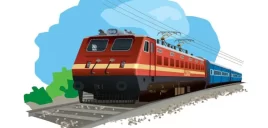This system is primarily used for single line routes (although it is seen on others too, e.g. MS-KMU-TPJ). The ball token system relies on the crew’s physical acquisition and carriage of a small metal ball to mark a train’s permission to enter a section of track. The ball is dispensed by a Token Instrument at either end of the block. The two instruments are interconnected so that at any given time, one and only one ball can be handed out from either of them, ensuring that only one train from either direction can enter the section of track (‘block’) controlled by them.
The token is dispensed by the token instrument only when the block indication is set to Train Going To (see above) after Line Clear has been granted and Train Coming From has been set by the receiving station. While the ball token is carried by a particular train’s crew, no other train may enter that section of the track. The token instruments at either end of the block will not give out any tokens until the token carried on the train currently in the block is returned to one of the token instruments. The block indication at the sending station cannot be changed from Train Going To until then. This is usually supplemented by mechanical interlock systems for the points on successive blocks of the tracks; changing the points at one block causes a notification at the signal box for the next block.
The ball token may be engraved with the station codes for the stations at either end, and usually also has a serial number. IR rules require the loco driver or assistant driver to enter the serial number in a register carried in the locomotive cab. In some variants of the ball token, such as tablet token systems, the token is so designed with different patterns of grooves on it that it cannot be inserted into the token instrument of the next one or two block sections beyond the section for which it was intended (in case it is carried beyond the receiving station in error.
A bell or other telegraph mechanism between signal boxes provides for communication of a few basic messages, such as whether the train is on a block, whether it has left the block, whether permission is granted to enter the block, whether a train has had to stop for an emergency in a block, whether it has had to reverse direction, etc. See the bell code below for the full details.
When a train stops at a station, the driver or assistant driver relinquishes any token they might have carried for the previous section, and picks up the token for the next section.
In case the train is ‘passing through’, i.e., not stopping at the station, the assistant driver puts on a thick arm protector and leans out of the loco. One of the station staff carries a reed and leather hoop about two feet in diameter with a pouch which holds the token. The assistant driver in one rapid move drops the older token and picks up the fresh token from this man standing on the ground. Then the assistant driver shows the green flag to the station master as well as honks the horn to indicate a good ‘pick up’. Then he shouts the token number along with the section name to the driver who enters it in his log. The token is picked up in the night in the same way, except the man from the station also carries a flaming kerosene soaked rag or lights a naphtha flare, to indicate his position in the darkness. A short (3′ – 4′) upright piece or rail or post, usually all white, sometimes with a stripe or two, and located close to the tracks, marks the position where the person handing out the token has to stand for the token exchange.
Picking up a token by hand is generally done only at low speeds. At higher speeds the hoop holding the token is actually mounted on a pick-up stand; the person on the ground stands next to it with a green flag. A pick-up rod on the side of the loco is positioned in just the right manner to snag the hoop and lift it off while the train is in motion. Impromptu “shock absorbers” made of used hose-pipe lengths were used on the side of the loco to prevent the token from being bumped around excessively thereby possibly breaking the hoop or pouch.
Source – IFRCA.org
Disclaimer: The Information /News /Video provided in this Platform has been collected from different sources. We Believe that “Knowledge Is Power” and our aim is to create general awareness among people and make them powerful through easily accessible Information. NOTE: We do not take any responsibility of authenticity of Information/News/Videos.
This entry was posted in 2 Railway Employee, STUDY NEW, Railway Employee











